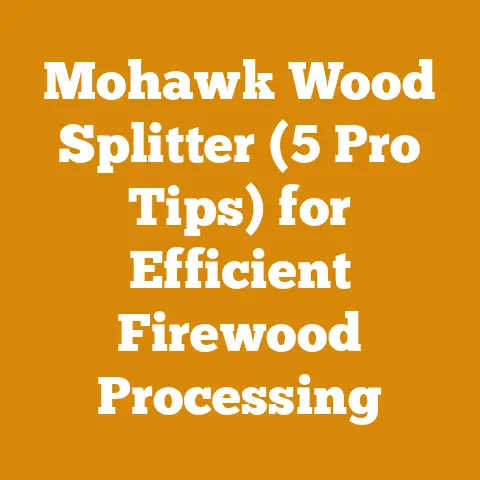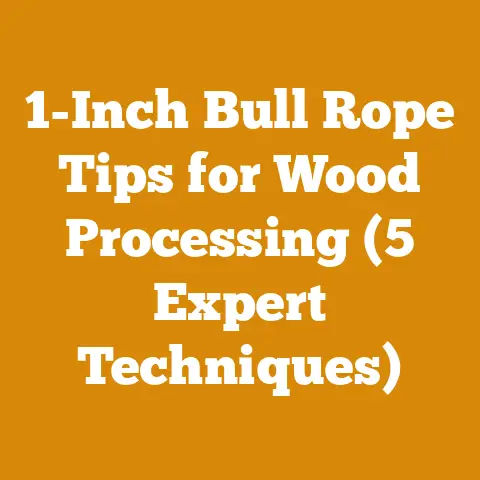How to Start Tree Removal Service (5 Pro Tips for Utah Arborists)
I once turned a tangled, overgrown patch of scrub oak into a profitable firewood operation in just one season. It wasn’t luck; it was a combination of hard work, smart planning, and a deep understanding of the tree removal and wood processing business, particularly in the unique landscape of Utah. Now, I’m going to share that knowledge with you. If you’re considering starting a tree removal service in Utah, this is your roadmap.
How to Start a Tree Removal Service: 5 Pro Tips for Utah Arborists
The tree removal business, especially in a state like Utah with its diverse landscapes and stringent regulations, can be incredibly rewarding. But it’s not for the faint of heart. It demands expertise, dedication, and a keen understanding of both the natural environment and the business landscape. These five pro tips are designed to give you a solid foundation to build a successful tree removal service.
1. Master the Art of Arboriculture: Knowledge is Your Strongest Tool
Before you even think about chainsaws and chippers, you need to become an arborist, or at least possess a strong working knowledge of arboriculture. This isn’t just about knowing how to cut down a tree; it’s about understanding tree biology, identifying diseases, assessing risk, and employing proper pruning and removal techniques.
- Why it matters: Utah’s diverse climate zones, from the high-altitude forests of the Uinta Mountains to the arid landscapes of the southern deserts, mean you’ll encounter a wide variety of tree species. Each species has its own unique characteristics, vulnerabilities, and best practices for care and removal.
- Data point: Improper pruning is a leading cause of tree decline and mortality. According to the International Society of Arboriculture (ISA), hiring a certified arborist can increase a tree’s lifespan by up to 50%.
- My experience: I once had a client who wanted a large oak tree removed because it was “too messy.” After assessing the tree, I discovered it was a heritage oak, over 150 years old, and perfectly healthy. I convinced the client to let me prune it instead, removing only deadwood and improving its structure. They were thrilled with the result, and I saved a magnificent tree.
- Actionable takeaway: Invest in formal arboricultural training. Consider becoming an ISA Certified Arborist. This certification not only demonstrates your expertise but also builds trust with potential clients. Look into courses offered at Utah State University or through local ISA chapters.
2. Gear Up for Success: Investing in the Right Equipment
The tree removal business is equipment-intensive. You’ll need a range of tools and machinery to handle different types of jobs safely and efficiently. Don’t cut corners here; quality equipment is an investment in your business and your safety.
- Essential Equipment Checklist:
- Chainsaws: Invest in several chainsaws of different sizes and power levels. A small chainsaw is ideal for pruning and limbing, while a larger, more powerful saw is necessary for felling large trees. Consider brands like Stihl, Husqvarna, and Echo.
- Climbing Gear: If you plan to tackle large or complex removals, you’ll need a full set of climbing gear, including a harness, ropes, carabiners, and climbing spurs.
- Wood Chipper: A wood chipper is essential for disposing of branches and smaller trees. Consider a towable chipper with a capacity that matches the size of the trees you’ll typically be removing.
- Truck and Trailer: You’ll need a reliable truck and trailer to transport your equipment and haul away debris. A dump truck is ideal, but a heavy-duty pickup truck with a trailer can also work.
- Safety Gear: Never compromise on safety. You’ll need helmets, eye protection, hearing protection, gloves, and chainsaw chaps.
- Other Tools: Axes, wedges, ropes, measuring tapes, first-aid kit, and traffic cones are all essential for safe and efficient tree removal.
- Data point: Investing in high-quality chainsaws can increase productivity by up to 20% compared to using cheaper, less reliable models.
- Unique insight: Consider renting specialized equipment, like a bucket truck or a crane, for larger or more complex jobs. This can save you the cost of purchasing and maintaining expensive equipment that you may not use regularly.
- My experience: I once tried to save money by buying a used wood chipper from an auction. It broke down constantly, costing me more in repairs and downtime than a new chipper would have. Lesson learned: invest in quality equipment from the start.
- Actionable takeaway: Create a detailed equipment list and prioritize your purchases based on your budget and the types of jobs you plan to handle. Research different brands and models, and read reviews from other arborists.
Utah has specific regulations governing tree removal, especially in urban areas and protected natural areas. Ignoring these regulations can result in hefty fines and legal trouble. Furthermore, operating without proper insurance is a recipe for disaster.
- Key Regulations and Requirements:
- Business License: You’ll need a business license to operate a tree removal service in Utah. Contact your local city or county government for information on how to obtain a license.
- Insurance: General liability insurance is essential to protect your business from lawsuits in case of accidents or property damage. Workers’ compensation insurance is required if you have employees.
- Permits: Many cities and counties require permits for tree removal, especially for trees on public property or in protected areas. Contact your local planning department for information on permit requirements.
- Utah Division of Forestry, Fire and State Lands (FFSL): Be aware of FFSL regulations regarding timber harvesting and forest management, especially if you plan to remove trees from private or public forest land.
- Environmental Regulations: Be aware of any environmental regulations that may apply to your tree removal activities, such as restrictions on removing trees near waterways or during nesting season.
- Data point: The average cost of a general liability insurance policy for a tree removal service in Utah is between $500 and $1,500 per year.
- Case study: A tree removal company in Salt Lake City was fined $10,000 for removing trees without a permit on city property. The company also faced negative publicity, which damaged its reputation and cost it business.
- Unique insight: Develop a strong relationship with your local planning department and city arborist. They can provide valuable guidance on regulations and help you avoid potential problems.
- My experience: I once had a client who wanted me to remove a tree that was located on a property line. Before I started work, I contacted the city planning department to confirm that I didn’t need a permit. It turned out that the tree was partially located on city property, and I needed to obtain a permit before I could remove it.
- Actionable takeaway: Research all applicable regulations and requirements before starting your tree removal service. Obtain all necessary licenses, permits, and insurance policies. Stay up-to-date on changes to regulations.
4. Market Your Expertise: Building a Strong Reputation
In a competitive market like Utah, you need to stand out from the crowd. Effective marketing is crucial for attracting new clients and building a strong reputation.
- Common Utah Wood Species:
- Oak: A dense, hardwood prized for its long burning time and high heat output. Scrub oak is common in Utah and makes excellent firewood.
- Maple: Another hardwood that burns well, although not as hot as oak. It’s easier to split than oak.
- Pine: A softwood that burns quickly and produces a lot of smoke. It’s best used for kindling or outdoor fires.
- Aspen: A softwood that is easy to split and ignite, but it burns quickly and doesn’t produce much heat.
- Juniper: A fragrant wood that burns hot and long. It’s often used for cooking and smoking.
- Pinyon Pine: A slow-growing pine that produces a flavorful smoke, making it ideal for cooking.
- Data point: Oak firewood has a BTU (British Thermal Unit) rating of approximately 28 million per cord, while pine firewood has a BTU rating of approximately 20 million per cord.
- Processing Techniques: The best processing method depends on the wood species and its intended use. Oak and maple are best split with a hydraulic splitter, while softer woods like pine and aspen can be split with an axe.
- My experience: I once processed a large pile of juniper that I had salvaged from a construction site. The wood was incredibly fragrant, and I sold it to local restaurants for use in their wood-fired ovens.
- Actionable takeaway: Learn to identify different wood species and understand their properties. This will help you process wood more efficiently and market it effectively.
Final Thoughts
Starting a tree removal service in Utah requires hard work, dedication, and a commitment to safety and professionalism. By mastering the art of arboriculture, investing in the right equipment, navigating the regulatory maze, marketing your expertise, and prioritizing safety, you can build a successful and rewarding business. Remember, your reputation is your most valuable asset. Treat your clients with respect, provide excellent service, and always put safety first. Good luck!






